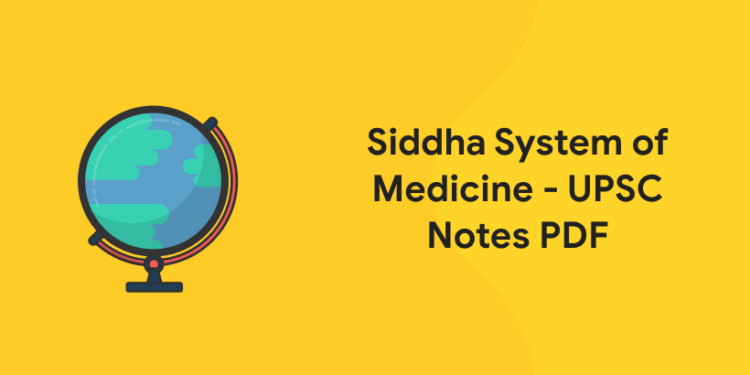Table of Contents
The Siddha system of medicine is one of India’s oldest medical systems. The term ‘Siddha’ refers to accomplishments, and ‘Siddhars’ were pious people who excelled in medicine. It is stated that eighteen Siddhars contributed to the establishment of this medical method. The Siddha medical system is largely used in portions of southern India.
Siddha System
Agastyar, also known as Agasthya, is considered to be the founder of Siddha Medicine. Siddha was born in India, which is where many old philosophies originated. This system can be traced all the way back to ancient Tamil civilisation.
The Siddha system of medicine is a traditional medical system that provides preventive, promotive, curative, rejuvenating, and rehabilitative health care using a scientific and holistic approach. The basic word “Citti” denotes “perfection,” “everlasting happiness,” and “accomplishment,” and the word “Siddha” is derived from it. In the Indian subcontinent, Siddha medicine has deep roots, reflecting the country’s culture, tradition, and heritage.
The Siddha system has four main divisions:
- Chemistry/Iatrochemistry Alchemy
- Treatment
- Yogic Practices
- Wisdom
Attempt Free General Knowledge Mock test! Download Entri App!
Siddha System – Origin
- Siddha vaidyam is a traditional healing method that developed in south India and is regarded as one of India’s oldest medical systems.
- The Siddha system of medicine is founded on a mix of traditional medicinal techniques, spiritual disciplines, alchemy, and mysticism.
- The siddha system of medicine, which has been practiced in ancient Tamil country, is the most advanced of all medical systems in the world.
- The Siddha System’s uniqueness is demonstrated by its continued service to humanity for more than 5000 years in battling ailments and sustaining physical, mental, and moral health, whereas many of its contemporaries had long since died out.
Siddha System – Five Elements
Earth, water, fire, air, and ether are the five elements that exist in nature, according to the Siddha system, and they all form the fundamental base of all corporeal things. The macrocosm of the external universe and the microcosm of the bodily being are thought to be intimately connected.
Humoral pathology
- In Siddha vaidyam, the elements air, fire, and water are stressed since they are said to make up the three fundamental components of the human constitution.
- All illnesses, according to humoral pathology beliefs, are produced by a discordant combination of vata, pitta, and kapha. Their bodily proportions influence a person’s physical and emotional health. The elements serve as a link between the microcosm (the person) and the macrocosm (the universe).
- Vata, according to the Siddhars, is self-generated and similar to heavenly energy. A vata imbalance could be the source of all sickness.
- Pitta was thought to represent all aspects of fire, including scorching, boiling, heating, and other comparable feelings. It was the name given to the heat contained in the liquid bile, which caused the waste stuff to be expelled in the form of urine and feces, and it was thought to give sight to the eyes, beauty to the skin, and cheerfulness to the mind.
- Kapha was thought to fill the body with moisture and provide stability, enhancing the body’s strength by increasing the hardness of the limbs and so keeping them in harmony with one another.
Attempt Free General Knowledge Mock test! Download Entri App!
Pranayama
Prana (Sanskrit pr) is the Sanskrit word for “breath.” Breathing is regarded the most crucial of all functions in Siddha medicine, as it provides energy and disease-free living. Controlled breathing, also known as pranayama in Yogic words, is a means of energizing oneself with vigor and personal magnetism.
Varmam
Varma is a part of Siddha medicine vaidyam that deals with the concept of varmam. The varmam are the sites where bone, muscle, tendons, nerves, and blood vessels come together. Disease, according to the ancient siddhars, appeared when these points were harmed by an external force. Ilakku murai is a manipulation technique used in Siddha treatment to restore health at the varmam. According to Siddha tradition, there are said to be 108 varmam.
Herbal and mineral treatment
- The siddhars conducted considerable plant research and discovered methods for using plants medicinally.
- They also classified plants based on how they affected the body and documented the poisonous nature of some plants as well as the antidotes for them.
- Unlike Ayurveda, which is another traditional Indian health system that emphasizes herbal treatment, Siddha medicine emphasizes the use of plants and minerals in combination.
- According to Siddha concept, preparations containing only mercury were thought to provide the body with anti-decay immunity, allowing it to fight sickness. Mercury and sulfur were thought to be the most powerful healers. Those minerals, on the other hand, are exceedingly harmful to humans.
- Chronic diseases and degenerative conditions such as rheumatoid arthritis, autoimmune conditions, collagen disorders, and central nervous system conditions have all been treated with Siddha treatment. Its efficacy in those settings has been mixed.
Attempt Free General Knowledge Mock test! Download Entri App!
Siddha System – Features
- Siddha treatment promises to be able to revitalize disease-causing organs.
- Siddha medicine’s specialities include:
-
- Kayakarpam, a unique combination of medicine and lifestyle
- Varmam therapy
- Vaasi (Pranayamam)
- Muppu, the universal salt
- According to legend, Shiva gave the Siddha medical system to his consort Parvati, who handed it on to Nandhidevar, who transmitted it on to the 18 Siddhars. As a result, it is referred to as ‘Shiva Sampradayam’ or ‘Siddha Sampradayam.’
Siddha Vaidyam
- The Siddha branch of medicine has produced a variety of medications, each containing a unique combination of metals, minerals, and other substances.
- Uppu: This medication system consists of 25 different water-soluble inorganic compounds made up of various alkalis and salts.
- Sulphur and mercury have an essential part in Siddha medicine.
- The natural medications make up half of the total, while the synthetic drugs make up the other half.
- Metals such as gold, silver, copper, lead, and iron are also often utilized in the manufacturing of various medicines.
- Seven more medications are heated, but they emit vapours and do not dissolve in water.
- Mercury is employed in five various forms in Panchasutha, including rasam (mercury), lingam (mercury red sulphide), veram (mercury perchloride), pooram (mercury subchloride), and rasa-chinduram (mercury subchloride) (red oxide of mercury)
Grab Latest GK Study Materials! Register Here!
Siddha System Global Scenario
- Siddha is a Dravidian religion practiced largely in southern India, Sri Lanka, Malaysia, Singapore, Mauritius, and other South-East Asian countries.
- The Siddha system of medicine is practiced in Sri Lanka, Malaysia, and Singapore, where there is a strong Tamil population.
- The Malaysian government regulates Siddha practice, registering practitioners under the Traditional and Complementary Medicine (TCM) division.
- Siddha education is provided in Sri Lanka via a department linked with Jaffna University and another institute affiliated with Eastern University in the Trincomalee Campus (undergraduate course).
Siddha System of Medicine – UPSC Notes PDF Download
I hope you found this article useful. The secret to clearing an exam is to prepare methodically and strategically. If you’re a candidate looking to start your dream job but don’t know where to start, our Entri app has you covered. Our staff will provide you with content and insights on the topics that affect you. Become a member of our app today and enroll in one of the many programs available. Stay up to date on various elements of the subject you’re interested in by using the app. Please feel free to leave any questions or concerns in the comments area. We will make every effort to reach back. Remove any self-doubts and negative thoughts from your mind. Make an effort to maintain a clear viewpoint. Consider why you desire this. Concentrate on the positive aspects of your situation and work diligently. Each day is a valuable gift that has been placed upon us, so make the most of it. Make an effort to improve yourself. Today is the day; let’s hope it goes well. Best wishes.














